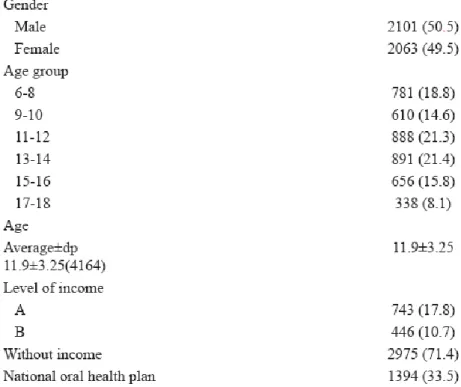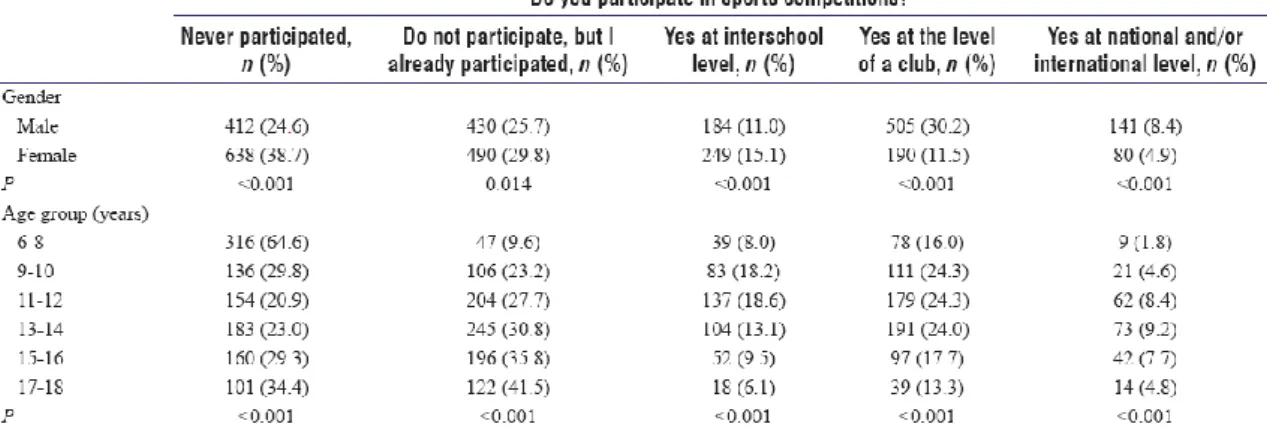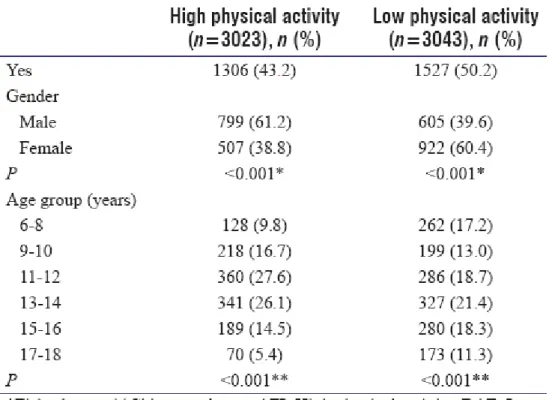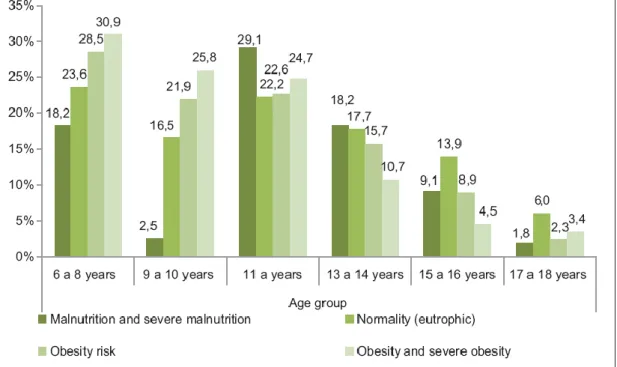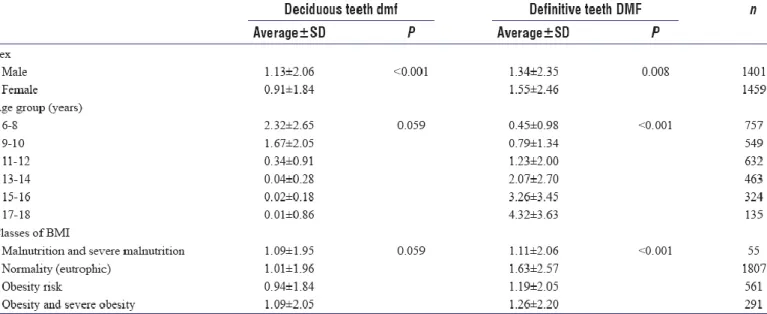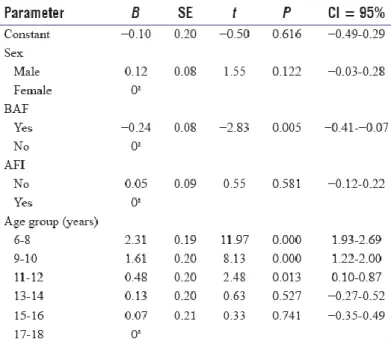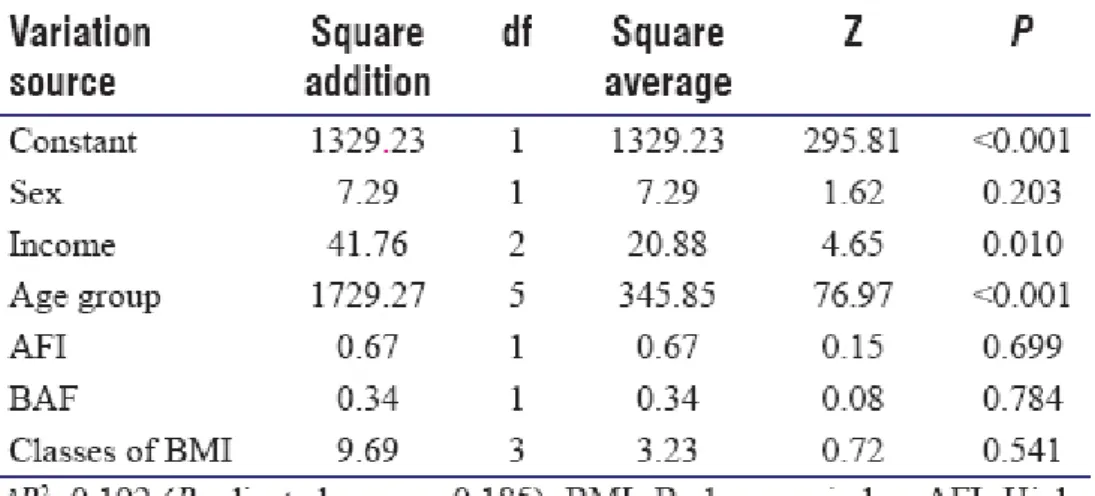Relationship between oral health and physical activity in a young population aged 6–18 years from Seixal's public schools, Portugal (2011–2014)
Octávio Rodrigues1, Susana Adam1, Mariana Freitas1, Ana Cristina Martins2, Ana Rita Granja3, Paulo Nogueira3, Tânia Moreira1, Nuno Simões1
1 Department of Oral health, Portuguese Association Promoter of Health and Oral Health - A.P.P.S.H.O, Seixal, Portugal
2 Department of Oral health, Faculty of Medicine, University of Lisbon, Lisbon, Portugal
3 Department of Oral health, Preventive Medicine Institute, Faculty of Medicine, University of Lisbon, Lisbon, Portugal
Abstract
Aims: This study aimed to evaluate oral health status, using index missing decomposition index for definitive teeth (DMF), Missing decomposition index for deciduous teeth (dmf), both in children and teenagers from Seixal's public schools, as well as to characterize the level of physical exercise practiced by these students and to analyze its possible relationship with oral health. Materials and Methods: A transversal study was performed using a group or sample of 4164 students, with ages between 6 and 18 years. Data were collected using a questionnaire adapted, to evaluate the amount of exercise practiced and the index of teeth with cavities, lost or crowned, to then evaluate their level of oral health. Results: It was verified that 43.2% of children and adolescents between 6 and 18 years of age practiced some form of regular or the high physical activity (AFI) was more common in men (61.2%) than in women (P <.001). All dmf indices were lower in girls (0.91±1.84) than in boys (1.13±2.06) (P < 0.001). Adolescents who practiced low physical activity (BAF) had, on average, a higher DMF index (DMFI). All DMFIs were higher in girls 1.55 ± 2.46 than in boys 1.34 ± 2.35 (P < 0.008). DMF rates also tended to increase with age. Conclusion: Using this study, it was possible to verify the correlation between dmf index and the practice of physical exercise. Male
teenagers showed higher dmf indexes. Besides, individuals who did not practice much physical exercise also showed high dmf indexes.
Keywords: Decayed missing filled/Decayed Missing Filled indexes, oral health, practice of physical exercise
Introduction
In recent decades, the World Health Organization (WHO) has focused on oral diseases such as dental caries, promoting and encouraging various follow-up programs. In some countries, with the adoption of some primary prevention programs, the incision and the prevalence of these oral diseases have decreased. However, tooth caries is still the number one cause of tooth loss, and it has been considered as an important social health problem. This is an important matter because tooth caries can be found in a large percentile of the population and because they are normally associated with other oral diseases. These characteristics represent high costs of treatment and have great influence on the quality of life of the individual.[1]
According to the WHO,[2] it is essential to share the results of oral health with a view to the recognition that the maintenance and prevention of dental health assume factors of improvement in the quality of life of individuals and helping to protect them from noncommunicable diseases.[3],[4],[5],[6]
As reported by the WHO,[7] physical activity in young people between 5 and 17 years of age should be at least 60 minutes and of vigorous intensity, as it will provide greater health benefit and disease prevention in the Adult.
The International Dental Federation [8] follows the same parameters of the WHO mentioning that the oral health is a health's essential component of the human being's health, in general, being a basic right for the contribution of a good quality of life. However, there are still enormous inequalities in the health-care access. At world level, the oral disease is the fourth treating costlier disease; dental decay affects most of the adults among 60%–90% of the children in school age.
According to the WHO,[10] the index of Decayed Missing Filled (DMF) expressed the number of decayed teeth, lost, and filled. This is the starting point for the diagnosis of patients' oral pathologies. Along this work, we will use the decayed missing filled (dmf) index for the deciduous teeth and DMF for the definitive dentition.
This research had as reference the situation of children and young people aged between 6 and 18 years, related to indices of dental caries (dmf / DMF) and to observe some relation with physical activity.
Materials and Methods Top
The selected individuals correspond to youths who frequented the grouping of Seixal's schools belonging to Setubal district (2011–2014). Ethical clearance was obtained from the School Ethical Committee. Informed consent was obtained from all the participants.
This study lasted 3 years during the period 2011-2014, with a retrospective analysis. A representative sample was used, in which 5081 questionnaires were applied; Of 5081, 4164 of the students were between 6 and 18 years old who attended public schools of the first, second and third cycles and secondary. The physical activity was measured with an adapted international questionnaire [9] and defined as to practice physical activity in extra school activities, in leisure, national and/or international sport competitions.
The analyzed independent variables were gender, age group, income level, indexes of dental (dmf/DMF) decay, and classes of body mass index (BMI).
To study the children and youth's behavior in what it concerns the practice of physical activity, starting from the questionnaire, a variable indicative of intense physical activity was built designated by AFI and another variable indicative of low physical activity designated by BAF. These variables were calculated based on the questionnaire.
The variable designated by AFI (High physical activity) contemplates the responses given by young people between 6 and 18 years to question Q1 “to practice extra-school sports” with the following possible answers: “2-3 times a week” and “ every day”. And it also includes question Q3 “to practice sport for at least 20 minutes” with the possible answers: “between 2 and 3 times a week,” “between 4 and 6 times a week,” or “everyday;” to question Q4 “practice sport activity to the point of being breathless or perspiring” with the possible answers “between 2 and 3 h,”
“between 4 and 6 h,” “7 or more hours;” and to question Q5 “participate in sport competitions” with the possible answers “interescolar level,” “the level of a club,” or “national and/or international level,” paying more attention to the items of the answers that indicated larger frequency of physical activity.
On the other hand, the variable BAF refers to the answers also given to the question Q1 with the possible answers “never practice sport activities,” “once a week;” to the question Q3 “never or once a month,” “between 2 and 4 times a month;” to the question Q4 “out of the school time not to dedicate to the practice of physical activity,” with the possible answers “never” and “between ½ and 1 h” considering more the items of answer of the inquiry that correspond to accomplish little or no physical activity.
However, question Q5 that corresponds to the practice of physical activity in sports competitions was treated separately, because there were multiple answers given by the participants, with the option of negative and
affirmative answers in the same question. The characterization and analysis of dental deterioration, such as the dmf index for deciduous teeth and DMF for the definitive dentition were obtained by the medical team based on
individual oral health records of the participants.
The observations found in the sample were stored in a database with the resource of the statistical program SPSS (Statistical Package for the Social Sciences), version 22.0 for Windows (IBM Corp., Armonk, NY, USA). To evaluate the contribution of the different factors in the variability of the several variables considered (dmf, DMF, and BMI), the main multifactorial effects investigated among the several models falling back on the general linear univariate model (glm). The analysis univariate (descriptive statistics), analysis bivariate (Fisher's exact test, Chi-square test), and analysis multifactorial (ANOVA multifactorial, glm) were used. For the whole inference, the level of significance considered was 0.05.
Results
From the 5081 questionnaires applied, 4164 students were aged between 6 and 18 years, in which 50.5% of the participants were male. The average age was 11.9 ± 3.25 years.
Families of the students with lower income have been classified in Levels A and B, which correspond to the income earners reference 1 and 2 of the social security. The step 1 is between €0 and €2934.54 and step 2 is between €2934.55 and €5869.08. It was considered without level income exceeding €5869.09. Nearly 17.8% of the students correspond to Level A and 10.7% to the Level B. One-third of respondents (33.5%), aged between 6 and 18 years, were covered by the National Oral Health Plan [Table 1].
Table 1: General characteristics of the enquired individuals
Characterization of the physical activity
Globally, in the physical activity characterization, significant differences were noted in relation to all the questions related to the practice of physical activity when detached from the individuals' gender (P < 0.001). Namely, in the question “Do you practice exercise extra school (in a club or another place),” there is a trend for a higher sports practice by the boys than by the girls, the proportion in the boys was 27.8% in the “once or twice a week” response, 12.5% “once a week”, 28.3% “2-3 times a week” and 31.2% “almost every day.” Concerning the question “Do you practice leisure activities without making part of a club,” a higher proportion of 25.2% in the boys with the answer “everyday” against 15.7% in the girls. As the question “Besides school sports, how often do you practice exercise during at least 20 min” is concerned, in the male group, 14.6% answered “everyday” (only 7.6% of girls). Finally, the question “Besides school, weekly time dedicated to the practice of sport activity to the point of being breathless or perspiring,” shows differences with a proportion in the male group of 20.3% in the answer “never,” 36.3% “between ½ and 1 h,” 29.1% “between 2 and 3 h,” 9.9% “between 4 and 6 h,” and 4.5% “7 or more hours.” Very different values were observed in the girls with 36.8% “never” and only 2% “7 or more hours” [Table 2].
Table 2: Physical activity characterization (frequency and intensity) by gender (n=3151)
Sports competitions.
For reasons related with the occurrence of multiple answers in this subject about the participation in sport competitions, the participation levels were analyzed separately.
Never participated
Globally, it was observed that 24.6% of the male and 38.7% of the female individuals when questioned if you “participate in sport competitions,” they answered “never participated.”
The distribution by age group was shown heterogeneous, particularly (P < 0.001); the tendency was the increase of the participation in sport competitions up to the 11–12 years and later decrease to the 17–18 years. A proportion of 64.6% was observed for children aged 6 to 8 years, 29.8% between 9 and 10 years, 20.9% between 11 and 12 years, 23.0% between 13 and 14 years, 29, 3% between 15 and 16 years and, finally, 34.4% between 17 and 18 years [Table 3], Columns 2 and 3].
I do not participate, but I already participated
The question of the physical activity in sport competitions “Do not participate, but I already participated” as for the distribution for gender was shown particularly heterogeneous (P = 0.014), 25.7% for the masculine sex and 29.8% for the feminine sex.
The distribution by age group was shown particularly heterogeneous (P < 0.001); a progression of increase of the proportion exists as the individuals' age also increases, being observed the proportion of 9.6% for the students between 6 and 8 years, 23.2% between 9 and 10 years; it is noted a quick increase for 27.7% for students between 11 and 12 years, 30.8% between 13 and 14 years, 35.8% between 15 and 16 years, and finally, 41.5% for individuals between 17 and 18 years of age [Table 3], Columns 5 and 6].
Yes at interschool level
Concerning the level of the participation in sport competitions “yes at interschool level,” the distribution for group sex was shown heterogeneous (P < 0.001), 11% for the masculine sex and 15.1% for the feminine sex. The
distribution for age group was also shown heterogeneous particularly (P < 0.001); the tendency of the participation in sport competitions increases in the students aged 11 and 12 years, and it decreases with increase of age to 17 and 18 years. The proportion of 8% was verified for students between 6 and 8 years; It increases 18.2% between 9 and 10 years and 18.6% for students between 11 and 12 years; There is a decrease in the participation of individuals with a proportion of 13.1% between 13 and 14 years, 9.5% for students between 15 and 16 years, and finally, 6.1% for individuals between 17 and 18 years of age [Table 3], Columns 7 and 8].
Yes at the level of a club
At the participation level in sport competitions at the “level of a club,” in the distribution for sex, significant differences were observed (P < 0.001), 30.2% for the masculine sex and 11.5% for the feminine sex. Furthermore, the distribution by age group was shown particularly heterogeneous (P < 0001), 16% for students between 6 and 8 years, 24.3% between 9 and 10 years and also the same proportion between 11 and 12 years; 24% for students between 13 and 14 years; 17.7% between 15 and 16 years; and 13.3% for the students between 17 and 18 years [Table 3], Columns 9 and 10].
Yes at national and/or international level
Concerning to the participation level in sport competitions “at national and/or international level,” significant differences are verified by sex (P < 0.001), 8.4% for the masculine sex and 4.9% for the feminine sex. For age group also, there were significant differences statistically (P < 0.001); 1.8% for students between 6 and 8 years; 4.6% between 9 and 10 years; 8.4% between 11 and 12 years; 9.2% between 13 and 14 years; 7.7% between 15 and 16 years; and 4.8% between 17 and 18 years.
These participation levels in sport competitions were revealed to be strongly associated to the age with a generally quadratic pattern. For the students aged 6–8 years, the students' two-thirds refer to have never participated in sport
competitions; for the students aged 11–12 years, this percentage decreases quickly for 21% and 79% for those who say to participate in sport competitions [Table 3], Columns 11 and 12].
Intense physical activity (AFI) and low physical activity (BAF) by sex and age group
Through the indicative variables of the levels of physical activity AFI and BAF built from the applied questionnaire, it was verified that 43.2% of the children and youths between 6 and 18 years revealed to practice in some way physical activity regularly or with intensity; on the other hand, 50.2% revealed not to practice sport physical activities. In agreement with the results presented in this article, significant differences were observed among the sexes (P < 0.001). The girls tended to be less active than the boys. Just about 38.8% of the girls have mentioned to have an intense (AFI) physical activity whereas the boys presented a proportion of 61.2% (AFI).
The feminine sex revealed to practice less physical exercise (BAF) with a proportion of 38.8%. Furthermore, there were differences registered in the variables of intensity of the physical activity, AFI and BAF (P < 0.001), for age group. It was noted the tendency for the variability of the physical activity as the youths grow. The intense sport practice was observed between 11 and 12 years as well as between 13 and 14 years of age, with the proportion of 27.6% and 26.1%, respectively. While for that same ages for the low physical activity, it is noted a decrease of the practice of physical activity as the age moves forward [Table 4].
Table 4: Percentage of individuals with high physical activity (AFI) and low physical activity (BAF) by gender and age group
The nutritional status of young people between 6 and 8 years of age presented a higher proportion in the normal BMI (eutrophic) class with 44.6%. The remaining nutritional states had lower proportions, with 1.4% of malnutrition and severe malnutrition, 13.8% of obesity risk, and 7.1% of obesity and severe obesity [Table 5].
Table 5: Nutritional state distribution (body mass index classes) by gender and total (n=2789)
The nutritional state showed to be associated to the individuals' sex. The distribution of the categories of BMI differed between boys and girls (P < 0.001). The girls presented the proportion of 68.6% in the nutritional state considered normal and the boys slightly below, with the proportion of 64.6%. The class of obesity risk presents the similar proportion between boys and girls; more boys were observed with obesity and severe obesity [Table 5].
Nutritional state by age group
The categories of BMI were shown to be highly associated to the individuals' age (P < 0.001). The students presented an increase of “severe malnutrition and malnutrition” up to 11–12 years of age. Proportions of 18.2% were verified in individuals with 6–8 years of age, 2.5% between 9 and 10 years, 29.1% between 11 and 12 years, with a decrease for 18.2% between 13 and 14 years of age, 9.1% between 15 and 16 years, and 1.8% for students between 17 and 18 years.
The same tendency was observed for students who presented the nutritional state as “normality,” that is, a proportion of 23.6% between 6 and 8 years; 16.5% for students with 9 and 10 years; 22.2% between 11 and 12 years; 17.7% between 13 and 14 years; 13.9% between 15 and 16 years and a decrease to 6% between 17 and 18 years. Higher proportions with “obesity risk” and “obesity and severe obesity” were observed in the first ages and decreased as the age moves forward. The proportion of “risk of obesity” was observed to be of 28.5% for ages between 6 and 8 years; 21.9% between 9 and 10 years; 22.6% between 11 and 12 years; 15.7% for ages between 13 and 14 years; 8.9% between 15 and 16 years; and 2.3% between 17 and 18 years.
Finally, for the nutritional state “obesity and severe obesity,” it was observed the proportion of 30.9% in the ages between 6 and 8 years; 25.8% between 9 and 10 years; 24.7% between 11 and 12 years; 10.7% between 13 and 14 years; 4.5% between 15 and 16 years; and 3.4% between 17 and 18 years of age [Figure 1].
Figure 1: Distribution of body mass index classes by age group
Characterization of the oral health (decayed missing filled and Decayed Missing Filled)
It was verified that the dmf in the age group of 6–8 years presented a value of 2.32 ± 2.65 which decreased with the age's increase due to physiologic loss of the deciduous teeth reaching a value of 0.01 ± 0.86 in the age group of 17– 18 years. In what it concerns, the DMF in the age group of 6–8 years presented a value of 0.45 ± 0.98 with increase along the age due to the eruption of the permanent teeth in the oral cavity [Figure 2]. In the age group of 17–18 years, an index of 4.32 ± 3.63 was observed. Significant differences in the dmf were verified among the individuals in relation to gender (P < 0.001) and also for DMF (P = 0.008). The same tendency was verified for the relative age group to the two indexes DMF (P < 0001). Significant differences of the classes were not observed relatively to BMI and dmf (P = 0.059); however, it existed differences for DMF (P < 0.001) [Table 6].
Figure 2: Evolution of the decayed missing filled (deciduous teeth) and Decayed Missing Filled (definitive teeth) by age group
Table 6: Characterization of the indexes of decayed teeth, lost and filled by sex, age group, and for classes of body mass index in the temporary (decayed missing filled) dentition and in the definitive dentition (Decayed Missing Filled)
Models for the relationship between oral health and physical activity
In this subsection, there were sought multifactorial models that relate dependent and the independent variables, through analysis of the respective main effects.
Decayed missing filled from the deciduous teeth
Considering the indicative variables separately AFI and BAF, it was verified to be related with the dmf of the deciduous teeth. However, simultaneously, when considered the main effects of the two variables, it was verified that the indicative variable of low physical (BAF) activity was the most relevant (P = 0.020), losing importance the variable AFI (P = 0.320), being in addition relevant the measurement of the variables family income, age group, and sex.
Like this, the explanatory model of the variation of the dmf of the deciduous teeth, considering the main effects of all the considered factors, shows association with the income (P = 0.029), age group (P < 0.001), and reduced practice of physical activity (P = 0.020). For the main effects of the model obtained and its interpretation, we obtained the estimates of the linear regression parameters underlying the linear model presented in [Table 7]. The results are shown in [Table 8] from which we can find:
Table 7: Multifactorial ANOVA for the variable decayed missing filled (considering the factors sex, income, AFI, BAF, age group, and classes of body mass index)
Table 8: Estimate of the parameters of the factors (sex, BAF, AFI, and age group) associated to the variable dependent decayed missing filled of the deciduous teeth (lineal regression)
Despite the variable sex being not revealed significant, after the control for the remaining factors (income, age group, and BAF), it was verified that the medium level of the dmf of the deciduous teeth tends to be higher in the male individuals than in the feminine sex
In a similar way, after the control of the remaining factors, the average of the dmf of the deciduous teeth is higher in the individuals with lower income (level A); For individuals with socioeconomic class B, the increase in relation to those with a better socioeconomic level - “without step” tends to be similar to that of those in step A (without the same level of evidence)
Relatively to the age group, after the control for the remaining factors, it was observed that the dmf of the
deciduous teeth is, on average, higher in the youngest (6–8 years) individuals and it decreases systematically as the individuals' age increases
After the control of the remaining considered factors, the individuals with low physical (BAF) activity have in average higher dmf, existing like this evidence of the relationship between physical activity and oral health.
Decayed Missing Filled from the definitive teeth
[Table 9] shows the results of the multifactorial ANOVA for the index DMF of the definitive teeth in the youths observed between 6 and 18 years of age considering the factors' main effects. It was observed that this index is associated to the income of the family of the inquired (P = 0.010) and to the age group of the individual (P < 0.001). There is no evidence of difference observed between the sexes (P = 0.203) or between the BMI classes (P = 0.541) or for the practice or not of intense physical activity. It was discovered that including the two indicative variables of the level of physical activity simultaneously did not reveal also additional explanation in the model AFI (P = 0.699) and BAF (P = 0.784) [Table 9].
Table 9: Multifactorial ANOVA for the variable Decayed Missing Filled of the definitive teeth (considering the factors sex, age group, AFI, BAF, classes of body mass index)
Thus, in individuals aged 6 to 18 years, the dental caries index (DMF) of the definitive teeth present a simple model and seems only to be explained by the socioeconomic level and by the age group of the individuals.
Discussion
In the national study about physical activity of Baptista et al., it concludes that the girls are less active than the boys.[10]
As we observe in the results given by this article, the girls are less active than the boys. Physical activity and healthy nutrition are crucial factors for a complete well-being.
According to the study of Global Oral Health,[8] dental caries affects 60%–90% of children worldwide. In this study, the value of DMF of definitive teeth, for 12-year children, is below 1.5 going exactly to the established goals of the OMS for 2020. In the matter of the individuals who were studied by the BMI class, all showed values below 1.5 of DMF of the definitive teeth, with and exception of the individuals considered normal by the BMI standards, which showed a total of 1.63 in the DMF.
The results presented by this study showed a connection between sex, age, and some physical activity with the dmf. In the majority of people with deciduous teeth, it is proven that there is a strong correlation between low intensity of physical activity with the higher numbers of dmf that being said it means that there are worst oral health and hygiene in those cases. When evaluating the number of caries, obturated and lost teeth of the permanent dentition, there was no evidence of any association between them. However, it is worth mentioning that the average of the levels of the dmf in people with deciduous teeth is higher in the individuals with a socioeconomic level situated at the scale A. For the B scale, there is a raise in the levels of the dmf of deciduous teeth, and for the individuals with “no scale,” there were no significant changes. The levels of the DMF of the permanent dentition when compared to the social economic level of the individuals appear to show similar conclusions. The study showed some limitations, mainly in the techniques used, because it was directed to the main effects that can be disguised by more complex situations. The study did not show a high level of explanations of dental caries levels (dmf / DMF) among the individuals, however, they showed a greater association in deciduous teeth (dmf) than in the definitive dentition levels (DMF). However, further studies are needed to better understand the nature of physical activity and dental caries levels. A relationship with the evolution of the age group was especially relevant, with jumps between BMI ranks increasing, being a predominance of normal weight with a more pronounced evolution in the female sex. These results demonstrate a strong dependence between social behaviors and physical activity that should be deepened in ad hoc studies.
Conclusion
This study was very important to verify a relationship between the DMF index and the physical activity of the individuals; however, other similar studies will be necessary to confirm this relationship.
Male teenagers and participants with low physical activity have the highest levels of DMF of the deciduous teeth. Moreover, knowing about this relationship, it becomes a priority to develop social interventions for children and teenagers that promote oral care, healthier food habits, and the practice of regular physical activities. This will increase their oral health and their quality of life.
Financial support and sponsorship Nil.
Conflicts of interest
There are no conflicts of interest.
References
1.Pereira C, Veiga N, Amaral O, Pereira J. Oral health behaviours in Portuguese adolescents, Portuguese Journal of Public Health,2013;31:158-65. Available from: http://www.scielo.mec.pt/ pdf/rpsp/v31n2/v31n2a04.pdf. [Last cited on 2015 Sep 19]. Back to cited text no. 1
2.World Health Organization. Strategies for Oral Disease Prevention and Health Promotion. Geneva: World Health Organization; 2000. Available from: http://www.who.int/oral_health/strategies/en/. [Last updated on 2015 Sep 15]. Back to cited text no. 2
3.Crispim MG, Grillo LP, Próspero ES, Mariath AP. Oral health and its association with nutritional status and socioeconomic condition in adolescents, 2010;58:41-6. Available from: http://www.revistargo.
com.br/include/getdoc.php?id=4588. [Last cited on 2015 Sep 19]. Back to cited text no. 3
4.World Health Organization. Childhood Overweight and Obesity. Geneva: WHO; 2012. Available from: http://www.who.int/dietphysicalactivity/ childhood/en/. [Last cited on 2015 Sep 15]. Back to cited text no. 4
5.Bergmann GG, Bergmann ML, Pinheiro ED, Moreira RB, Marques AC, Garlipp DC, et al. Body mass index: secular trends in children and adolescents from Brazil. Brazilian Journal of Kinanthropometry and Human Performance, 2009; 11:280-85. Available from: http://hdl.handle.net/10183/87056. [Last cited on 2015 Sep 22]. Back to cited text no. 5
6.Ceschini FL, Andrade DR, Oliveira LC, Araújo Júnior JF, Matsudo VK. Prevalence of physical inactivity and associated factors among high school students from state's public schools. Journal Pediatrics. 2009; 85:301-6. Available from: http://dx.doi.org/10.1590/S0021-75572009000400006 [Last cited on 2015 Sep 22]. Back to cited text no. 6
7.World Health Organization. Global Recommendations on Physical Activity for Health. Geneva: WHO; 2012. Available from: http://www.who.int/dietphysicalactivity/ publications/pa/en/. [Last cited on 2015 Sep 21]. Back to cited text no. 7
8.World Health Organization. Global Recommendations on Physical Activity for Health. Geneva: WHO; 2012. Available from: http://www.who.int/dietphysicalactivity/ publications/pa/en/. [Last cited on 2015 Sep 21]. Back to cited text no. 8
9.Mota J, Santos P, Guerra S, Ribeiro JC, Duarte JA, Sallis J. Validation of a physical activity self-report questionnaire in a Portuguese pediatric population. Pediatr Exerc Sci 2002;14:269-76. Available from:
http://www.researchgate.net/publication/235335164_Validation_of_a_physical_activity_self-report_questionnaire_in_a_Portuguese_pediatric_population. [Last cited on 2015 Sep 21]. Back to cited text no. 9
10.Baptista F, Silva A, Santos D, Mota J, Santos R, Vale S, et al. Green Paper of the Activity: Department of Sports and Health. 2011. Portuguese Sports Institute. Available from:
http://www.observatorio.idesporto.pt/Multimedia/Livros/Aptidao/LVAptidao.pdf. [Cited on 2015 Sep 21]. Back to cited text no. 10
